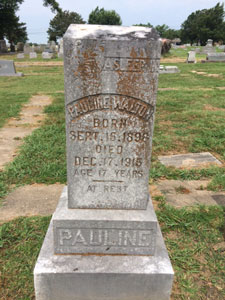
The grave site of Pauline Walton, who was violently murdered in December 1915. Look closely at the stone to see if you can find a clue. It is a murder full of mysteries.
I always said I wouldn’t try to write fiction. It is simply too hard to put words in a character’s mouth. Well, I just finished my first attempt at historical fiction, although there is only a miniscule of conversation in it.
Some of you who follow me on Facebook might remember last December when I reported a man was sent to Greenville from Paris to be held in our jail. It seems he was charged with the horribly atrocious murder of his oldest child and only daughter. The authorities in Paris felt he would be safer here where the irate mob couldn’t take the law into their own hands.
A friend who loves mysteries asked me to find out more and write it up. I decided it was time to try my hand at a semi-fictional work. While it is based on newspaper reports of the five years between the times the suspect was arrested and the final jury convicted and sentenced him, there are bits and pieces where I had to ad lib. That is what turned a typical report I would do into a piece of historic fiction.
I found the hardest part was not conversation but finding a format that worked. This series of articles is the only work I write that is not footnoted. But who, besides a historian, wants to be annoyed with those little numbers at the end of most lines. So I faced such questions as: 1) did I need a narrator? 2) should it be told in first person singular or third person singular? 3) in what tense, past or present, should it be?
I turned to my favorite mystery writers. Being 69% English according to my DNA tests, I favor Dorothy Sayers, Arthur Conan Doyle, and Agatha Christie. I read all of their works I can get my hands on. I agonized over sentences, over the order of events, and how to end the piece. But I finished with less than a week before it was due.
So with that free time, I discovered I had downloaded an Agatha Christi on my laptop some time ago. It was Secret Adversary, published in 1922 and first of the Tommy and Tuppence Series. It opened with an introduction citing events about the final moments aboard the Lusitania. Now I am absolutely fine on the Fourth of July reading a murder mystery.
Will I try historical fiction again? Probably as I do have an unusual collection of strange stories I have obtained through the years. But if you are interested in hearing “Who Killed Pauline?” I am telling the story, briefly of course, at the Texas Theater next Wednesday at 5:00 P.M. The event is free and all are invited.
When I feel that I am ready to publish Who Killed Pauline?, I will unveil it here on my blog. But in the meantime, I will tell you a secret. I don’t know that the real murderer was the one sent to prison. Stay tuned!
